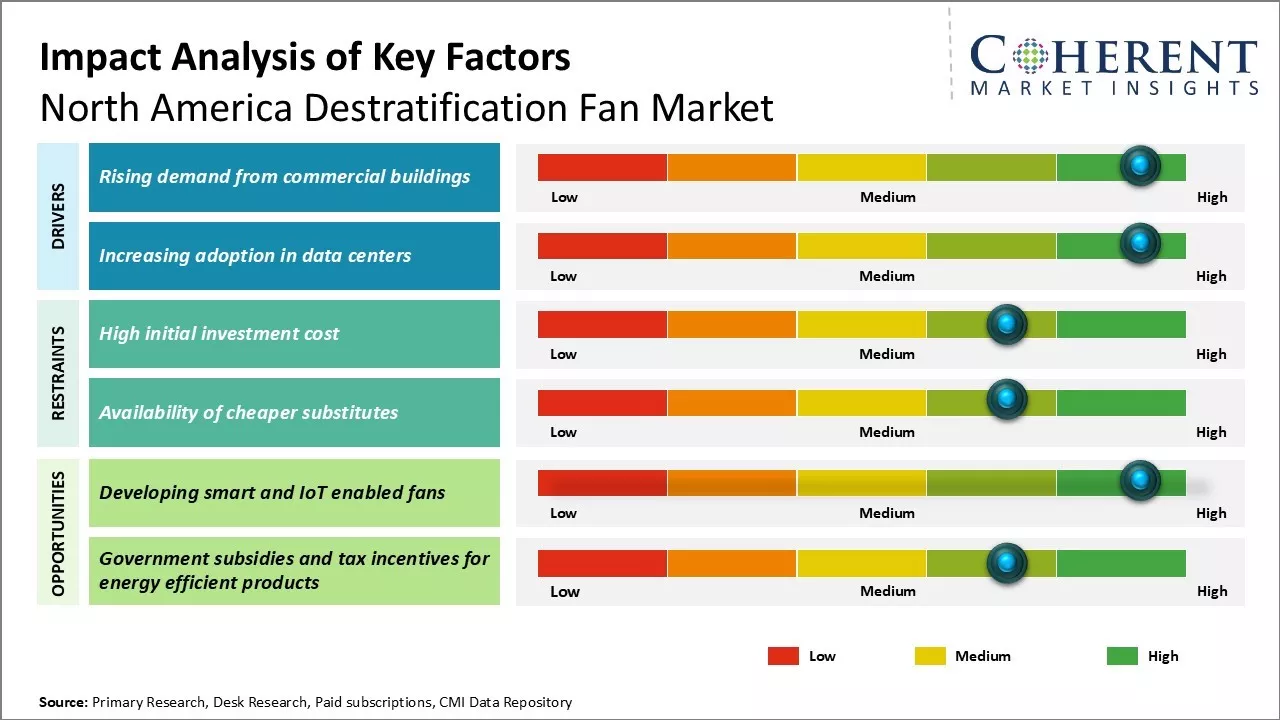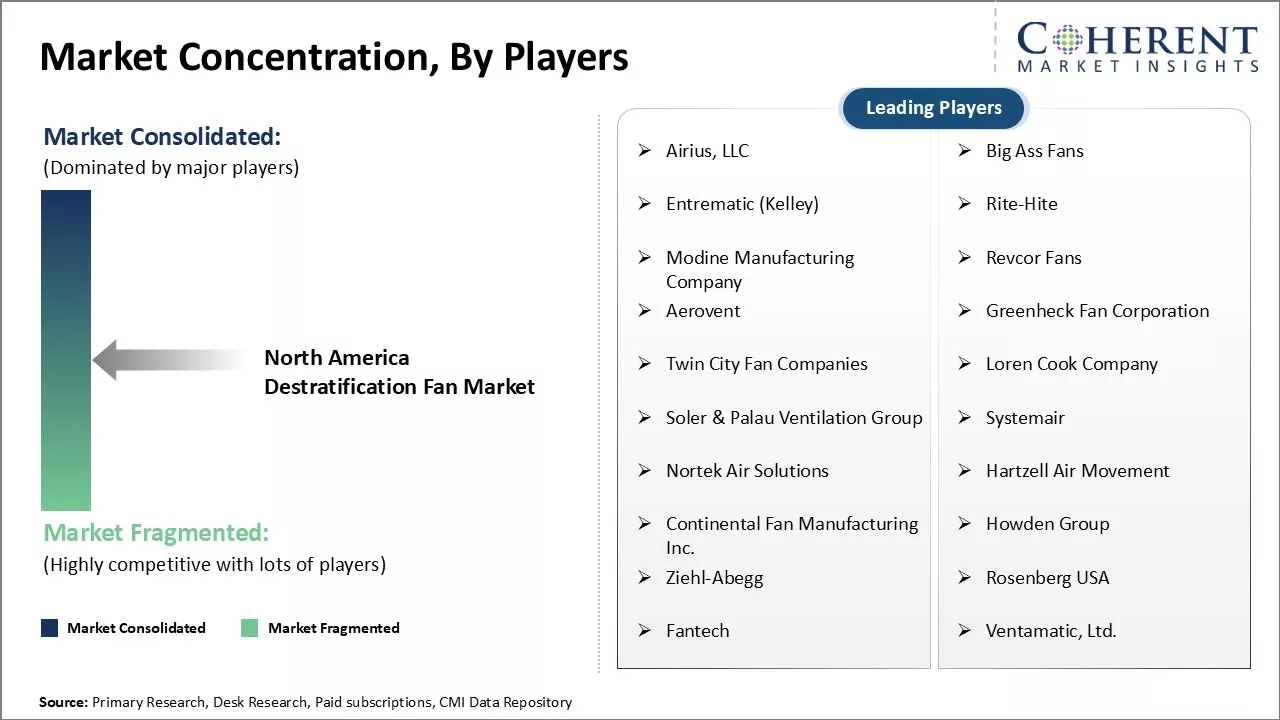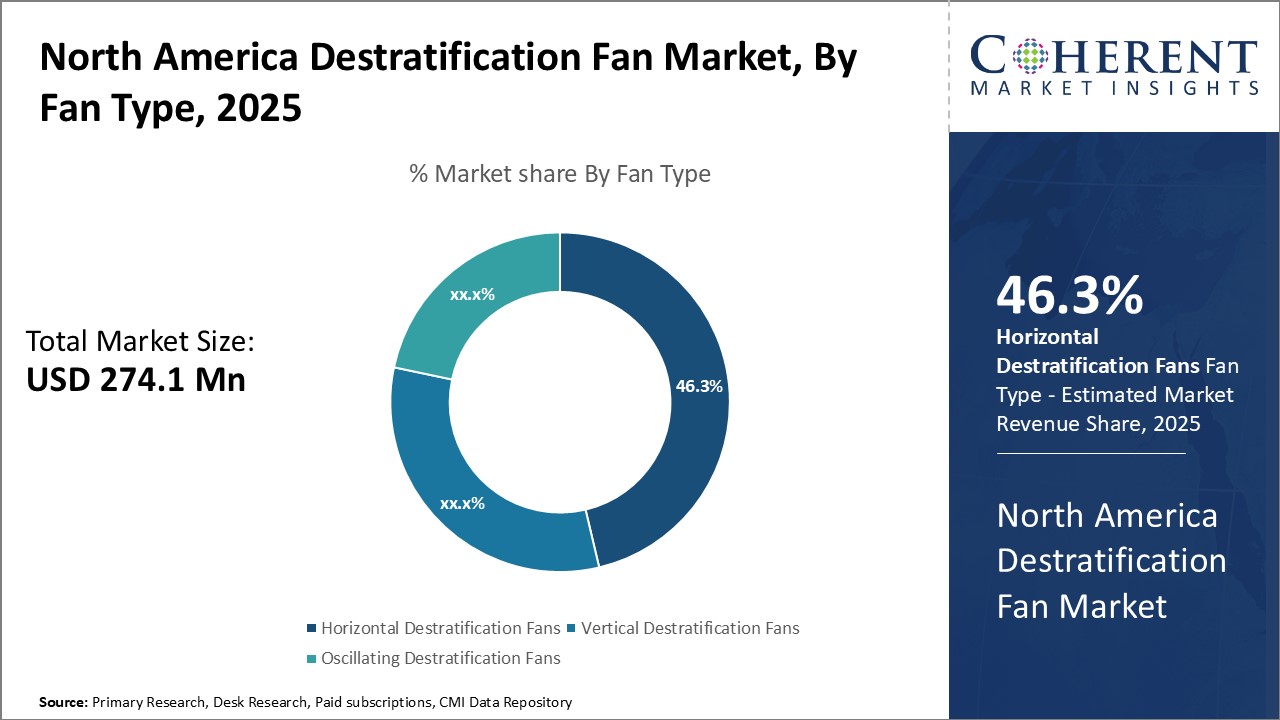North America Destratification Fan Market Size and Trends
North America destratification fan market is estimated to be valued at USD 274.1 Mn in 2025 and is expected to reach USD 461.0 Mn by 2032, exhibiting a compound annual growth rate (CAGR) of 7.7% from 2025 to 2032.

Discover market dynamics shaping the industry: Download Free Sample
Increasing construction of commercial buildings along with growing focus on indoor environment quality can boost demand for destratification fans. These fans help in circulating air evenly throughout buildings and help maintain uniform temperature. These also improve thermal stratification, which leads to improved energy efficiency and lower energy bills. Growing emphasis on energy efficiency and minimum carbon footprint from heating and cooling systems can boost demand for destratification fans. Replacement of aging Heating, ventilation, and air conditioning systems as well as installation of advanced controls to manage temperature and air quality can boost sales of destratification fans.
Market Driver - Rising demand from commercial buildings
The demand for destratification fans is growing rapidly in the commercial building sector across North America. As businesses look to optimize energy usage and reduce costs, destratification has become an increasingly important strategy. Destratification fans help to mix the hot and cold air in large indoor spaces, preventing the formation of distinct temperature layers. This leads to a more uniform and comfortable environment while using less energy for heating and cooling.
Commercial properties with high ceilings such as warehouses, factories, and retail stores stand to benefit greatly from destratification. For example, a large warehouse may have temperatures of 75 degrees F at the floor but over 85 degrees near the ceiling. Installing powerful ceiling fans allows the air to mix more evenly throughout the space. Field studies show these fans can cut annual HVAC costs by 10-30% in suitable buildings. They tend to see the shortest payback times compared to other energy efficiency upgrades.
In addition, as more businesses adopt net-zero goals to reduce their environmental footprint, destratification fans are increasingly part of the solution. By minimizing temperature variations, buildings need less extreme heating and cooling to maintain comfort. This delivers ongoing savings in energy usage and greenhouse gas emissions. Recent data from the International Energy Agency shows commercial building emissions must fall by 30% globally by 2030 to achieve net-zero targets. Efficient technologies like destratification fans that optimize existing HVAC systems will be critical to making progress on these ambitious climate goals.
Market Concentration and Competitive Landscape

Get actionable strategies to beat competition: Download Free Sample
Increasing adoption in data centers
As modern life becomes increasingly digitalized, the reliance on data centers with extensive server infrastructure has surged dramatically over the past decade. To meet the growing demand for data processing, these facilities are expanding their server capacity and floor space, which has made maintaining optimal thermal conditions a significant challenge. Even slight increases in the temperature of servers and other IT equipment can severely affect their performance and lifespan.
Traditional cooling methods that rely on raised floor airflow designs are proving inadequate for the newer generation of data centers, which feature ultra-dense server configurations. The rising electricity consumption of large air conditioning units undermines their claims of energy efficiency. Consequently, data center operators are exploring additional techniques to minimize overcooling without allowing temperatures in the IT zones to rise. Destratification fans are becoming increasingly popular, as they can help lower cooling set points by mitigating temperature stratification.
Leading cloud service and hyperscale providers are at the forefront of testing destratification technology within their advanced data center campuses. Field studies have shown that these intelligent fans can increase rack inlet temperatures by 1-2°C without adversely affecting the conditions in IT or support spaces. This improvement can lead to significant energy savings by reducing the size of chillers or allowing for over 15% more servers to be accommodated within the same footprint. In an industry characterized by hyper-competitive dynamics and continuous expansion, even small gains in resource efficiency can have substantial business value.
Key Takeaways from Analyst:
Increasing adoption of smart home technologies across both residential and commercial sectors can drive the market growth as these fans can be automated and controlled remotely. Stringent energy regulations aimed at improving HVAC efficiency also provide opportunities for fans that promote natural convection.
High initial costs as compared to traditional ceiling fans can hamper its mass adoption. Disruptions in the construction industry due to COVID-19 also pose a short-term restraint as projects are delayed. Relatively complex installation process requires expertise and increases expenses.
The U.S. currently dominates the market, owing to rising investments in smart infrastructure and green buildings. California is expected to lead demand for destratification technologies due to its ambitious emission reduction targets. Canada will witness considerable gains due to government incentives for energy efficient products.
Market Challenge - High initial investment cost
North America destratification fan market growth can be hampered due to high initial investment cost associated with installing destratification fans. These fans require substantial upfront capital expenditure to purchase the equipment as well as perform the necessary installation and modifications to existing HVAC systems. The fans are expensive than conventional HVAC fans due to their more advanced engineering and components designed for optimized air circulation. Retrofitting older buildings with destatification fans often demands extra costs for ductwork alterations, electrical works, and other infrastructure upgrades to support the new equipment. These high initial costs pose a significant barrier for potential customers and building owners to adopt destratification fan technology. With tighter budgets and longer payback periods, promoting the total energy savings and return on investment that destratification fans provide over time will be important to drive the market growth.
Market Opportunity - Developing smart and IoT enabled fans
North America destratification fan market can witness growth opportunities from developing smarter and more internet of things (IoT) enabled fan solutions. By incorporating advanced automation, controls and remote monitoring capabilities, next-generation destatification fans can provide improved performance and energy efficiencies. For example, fans with built-in sensors and intelligent speed adjustments can automatically optimize operations based on real-time temperature differentials in the building. Connecting the fans to cloud-based analytics platforms also allows facility managers to remotely access run-time data, diagnose issues faster as well as schedule and program maintenance from any location. Development of self-learning algorithms and AI could further enhance automation functionalities Implementing an IoT-driven product roadmap will enable destratification fan vendors to meet the needs of commercial customers seeking to modernize outdated systems with smart, connected technologies that promote sustainability and cost savings.

Discover high revenue pocket segments and roadmap to it: Download Free Sample
Insights, By Fan Type: Engineering excellence boosts demand for horizontal destratification fans
By fan type, horizontal destratification fans segment is estimated to contribute the highest market share of 46.3% in 2025, owing to their engineering excellence and versatility. Horizontal fans are designed with precisely engineered propellers and motors that enable highly efficient distribution of air across wide industrial, commercial and residential spaces. Their horizontal orientation allows for sweeping 360-degree air movement without obstructions. This makes horizontal fans ideal for large open areas like warehouses, distribution centers, exhibition halls, gymnasiums, stadiums and more.
The engineering prowess behind horizontal fan design also means these offer stronger airflows as compared to other fan types. Their powerful motors and aerodynamic blades can easily reach areas underneath mezzanines, balconies and tall shelves, effectively combating stratification in high ceilings. This specialized air distribution capability makes horizontal fans a top choice for industries like food & beverage manufacturing and pharmaceuticals, where temperature uniformity is critical for product quality and food safety. Some horizontal fan models even integrate variable speed controls and remote monitoring for precise thermal regulation tailored to specific temperature needs.
Horizontal destratification fans also tend to have a longer lifespan than alternatives due to their robust construction featuring industrial grade, corrosion resistant materials. Combined with lower maintenance needs, this lifecycle reliability appeals greatly to commercial real estate managers and factory operators seeking to maximize equipment uptime. Many leading horizontal fan brands even back their products with long warranties of 10 years or more, thus, providing customers durable solutions that preserve their capital investments after many years of use.
Horizontal fans consume less floor space as compared to multiple vertical units to cover the same area. This compact design conserves valuable industrial real estate that many distribution centers and warehouses currently lack. Horizontal destratification fans remain the most suitable and widely deployed solution across North America's largest industrial and commercial facilities.
Insights, By Application: Residential comfort boosts demand for oscillating destratification fans
By application, residential segment is estimated to contribute the highest market share of 29.2% in 2025. Destratification fans are increasingly being applied in the residential segment to enhance energy efficiency and improve indoor comfort. These fans work by redistributing warm air that naturally rises to the ceiling back down to the living space, effectively eliminating temperature stratification. In homes with high ceilings, this can lead to a more consistent and comfortable temperature throughout the room, reducing the need for excessive heating during colder months. By maintaining an even temperature, destratification fans can help homeowners save on energy costs, as they allow heating systems to operate more efficiently. Additionally, these fans can contribute to improved air quality by promoting better airflow and circulation, making them a valuable addition to residential HVAC systems. Overall, the integration of destratification fans in homes not only enhances comfort but also supports energy conservation efforts, aligning with the growing trend toward sustainable living.
Insights, By Sales Channel: Direct sales channels enhance product accessibility
By sales channel, direct sales segment is estimated to contribute the highest market share of 39.2% in 2025, owing to their effectiveness in directly reaching both residential and commercial customers. Selling fans through company owned online stores and affiliate e-commerce websites allows brands optimal control over the end consumer experience from product discovery to post purchase support. This helps instill confidence for buyers seeking quality commercial HVAC solutions.
Direct channels also enable brands to engage customers through rich product information like detailed specifications, performance ratings and application guides right on their own digital properties. Instead of relying on partners, brands can ensure their technical expertise and unique value propositions around things like energy efficiency, airflow control and reliability are clearly communicated. This education coupled with highly visual content demonstrating fan installation and use across various facility types helps buyers confidently match the right solutions to their specific needs.
Selling online or through a dedicated in-house sales team further guarantees consistent branding, pricing and availability which helps establish long term customer relationships. Many North American fan manufacturers now provide one-stop sourcing on their websites for complementary accessories, spare parts, and maintenance packages. This convenience through direct channels compels customers accustomed to omnichannel retail experiences. It also optimizes opportunities for repeat and expanded basket purchases over time.
Market Report Scope
North America Destratification Fan Market Report Coverage
| Report Coverage | Details | ||
|---|---|---|---|
| Base Year: | 2024 | Market Size in 2025: | USD 274.1 Mn |
| Historical Data for: | 2020 To 2024 | Forecast Period: | 2025 To 2032 |
| Forecast Period 2025 to 2032 CAGR: | 7.7% | 2032 Value Projection: | USD 461.0 Mn |
| Segments covered: |
|
||
| Companies covered: |
Airius, LLC, Big Ass Fans, Entrematic (Kelley), Rite-Hite, Modine Manufacturing Company, Revcor Fans, Aerovent, Greenheck Fan Corporation, Twin City Fan Companies, Loren Cook Company, Soler & Palau Ventilation Group, Systemair, Nortek Air Solutions, Hartzell Air Movement, Continental Fan Manufacturing Inc., Howden Group, Ziehl-Abegg, Rosenberg USA, Fantech, and Ventamatic, Ltd. |
||
| Growth Drivers: |
|
||
| Restraints & Challenges: |
|
||
Uncover macros and micros vetted on 75+ parameters: Get instant access to report
North America Destratification Fan Industry News
- In May 2024, Airius, a leading manufacturer of destratification fans, unveiled its latest innovation - Onyx 560. This cutting-edge fan boasts superior cooling capabilities and enhanced versatility, thus, making it an ideal choice for a wide range of commercial and industrial applications.
- In 2021, Rite-Hite introduced a new management system designed for optimal control of HVLS fans.
*Definition: North America destratification fan market involves the sales of destratification fans in the countries of North America. Destratification fans are used to mechanically mix the air in large indoor spaces like warehouses, factories, and storage facilities to prevent the formation of hot and cold air pockets. These help maintain a uniform temperature throughout height and improve ventilation. The main types of destratification fans sold are ceiling mounted, portable and wall mounted.
Market Segmentation
- Fan Type Insights (Revenue, USD Mn, 2020 - 2032)
-
- Horizontal Destratification Fans
- Vertical Destratification Fans
- Oscillating Destratification Fans
- Application Insights (Revenue, USD Mn, 2020 - 2032)
-
- Industrial
- Commercial
- Residential
- Sales Channel Insights (Revenue, USD Mn, 2020 - 2032)
-
- Direct Sales
- Distributors and Dealers
- Key Players Insights
- Airius, LLC
- Big Ass Fans
- Entrematic (Kelley)
- Rite-Hite
- Modine Manufacturing Company
- Revcor Fans
- Aerovent
- Greenheck Fan Corporation
- Twin City Fan Companies
- Loren Cook Company
- Soler & Palau Ventilation Group
- Systemair
- Nortek Air Solutions
- Hartzell Air Movement
- Continental Fan Manufacturing Inc.
- Howden Group
- Ziehl-Abegg
- Rosenberg USA
- Fantech
- Ventamatic, Ltd.
Share
Share
About Author
Ramprasad Bhute is a Senior Research Consultant with over 6 years of experience in market research and business consulting. He manages consulting and market research projects centered on go-to-market strategy, opportunity analysis, competitive landscape, and market size estimation and forecasting. He also advises clients on identifying and targeting absolute opportunities to penetrate untapped markets.
Missing comfort of reading report in your local language? Find your preferred language :
Transform your Strategy with Exclusive Trending Reports :
Frequently Asked Questions
EXISTING CLIENTELE
Joining thousands of companies around the world committed to making the Excellent Business Solutions.
View All Our Clients
